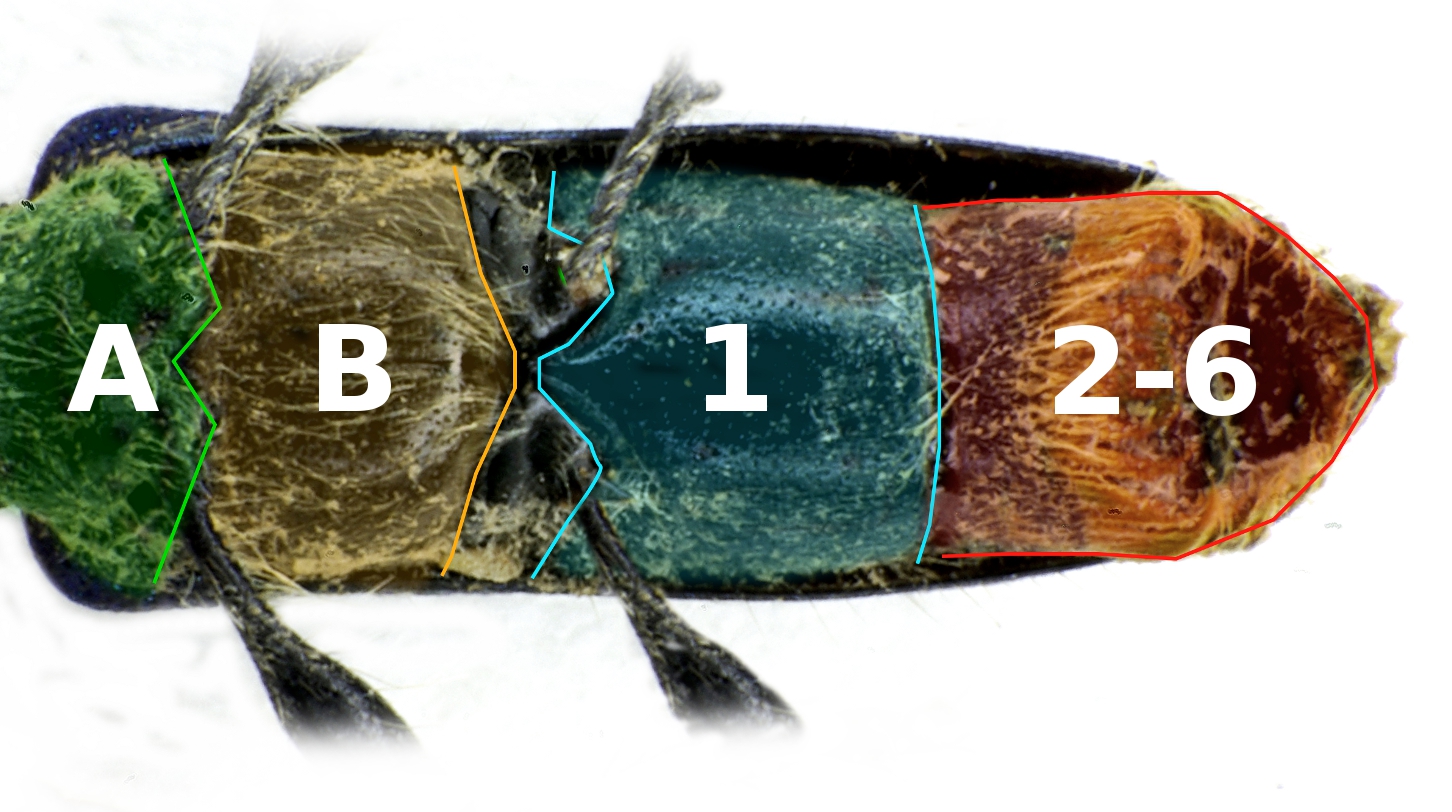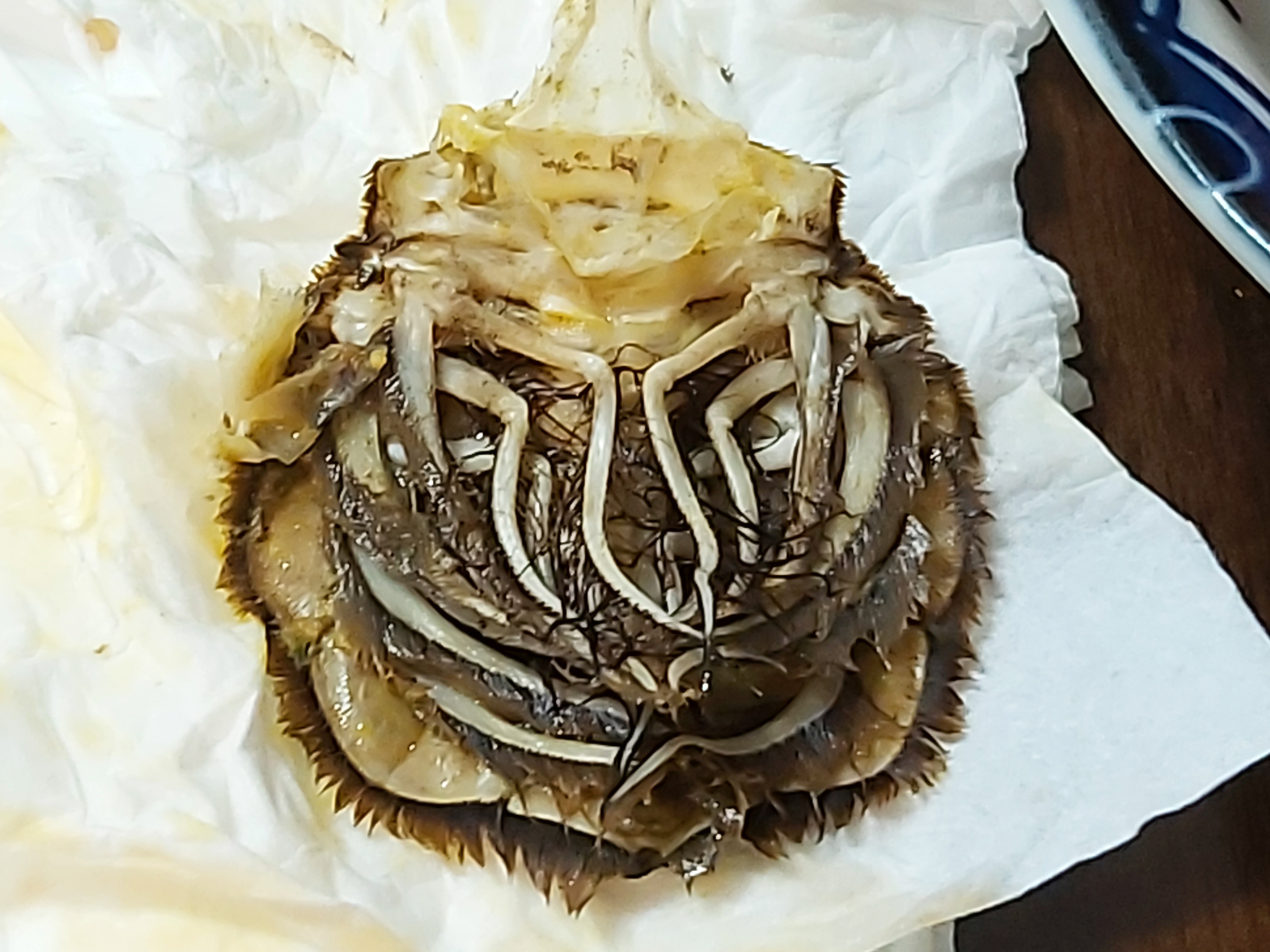|
Sternite
The sternum (: sterna) is the ventral portion of a segment of an arthropod thorax or abdomen. In insects, the sterna are usually single, large sclerites, and external. However, they can sometimes be divided in two or more, in which case the subunits are called sternites, and may also be modified on the terminal abdominal segments so as to form part of the functional genitalia, in which case they are frequently reduced in size and development, and may become internalized and/or membranous. For a detailed explanation of the terminology, see Kinorhynchs have tergal and sternal plates too, though seemingly not homologous with those of arthropods.Sørensen, M. V. et al. Phylogeny of Kinorhyncha based on morphology and two molecular loci. PLoS One 10, 1–33 (2015). Ventrites are externally visible sternites. Usually the first sternite is covered up, so that ventrite numbers do not correspond to sternite numbers. The term is also used in other arthropod groups such as crustaceans, ... [...More Info...] [...Related Items...] OR: [Wikipedia] [Google] [Baidu] |
Arachnid
Arachnids are arthropods in the Class (biology), class Arachnida () of the subphylum Chelicerata. Arachnida includes, among others, spiders, scorpions, ticks, mites, pseudoscorpions, opiliones, harvestmen, Solifugae, camel spiders, Amblypygi, whip spiders and Uropygi, vinegaroons. Adult arachnids have eight Arthropod leg, legs attached to the cephalothorax. In some species the frontmost pair of legs has converted to a sensory function, while in others, different appendages can grow large enough to take on the appearance of extra pairs of legs. Almost all Extant taxon, extant arachnids are terrestrial animal, terrestrial, living mainly on land. However, some inhabit freshwater environments and, with the exception of the pelagic zone, marine environments as well. They comprise over 110,000 named species, of which 51,000 are species of spiders. The term is derived from the Ancient Greek, Greek word (''aráchnē'', 'spider'), from the myth of the hubristic human weaver Arachne, w ... [...More Info...] [...Related Items...] OR: [Wikipedia] [Google] [Baidu] |
Arthropod
Arthropods ( ) are invertebrates in the phylum Arthropoda. They possess an arthropod exoskeleton, exoskeleton with a cuticle made of chitin, often Mineralization (biology), mineralised with calcium carbonate, a body with differentiated (Metamerism (biology), metameric) Segmentation (biology), segments, and paired jointed appendages. In order to keep growing, they must go through stages of moulting, a process by which they shed their exoskeleton to reveal a new one. They form an extremely diverse group of up to ten million species. Haemolymph is the analogue of blood for most arthropods. An arthropod has an open circulatory system, with a body cavity called a haemocoel through which haemolymph circulates to the interior Organ (anatomy), organs. Like their exteriors, the internal organs of arthropods are generally built of repeated segments. They have ladder-like nervous systems, with paired Anatomical terms of location#Dorsal and ventral, ventral Ventral nerve cord, nerve cord ... [...More Info...] [...Related Items...] OR: [Wikipedia] [Google] [Baidu] |
Myriapod
Myriapods () are the members of subphylum Myriapoda, containing arthropods such as millipedes and centipedes. The group contains about 13,000 species, all of them terrestrial. Although molecular evidence and similar fossils suggests a diversification in the Cambrian Period, the oldest known fossil record of myriapods dates between the Late Silurian and Early Devonian, with '' Pneumodesmus'' preserving the earliest known evidence of air-breathing on land. Other early myriapod fossil species around the similar time period include '' Kampecaris obanensis'' and '' Archidesmus'' sp. The phylogenetic classification of myriapods is still debated. The scientific study of myriapods is myriapodology, and those who study myriapods are myriapodologists. Anatomy Myriapods have a single pair of antennae and, in most cases, simple eyes. Exceptions are the two classes of symphylans and pauropods, the millipede order Polydesmida and the centipede order Geophilomorpha, which are all ey ... [...More Info...] [...Related Items...] OR: [Wikipedia] [Google] [Baidu] |
Tergite
A ''tergum'' (Latin for "the back"; : ''terga'', associated adjective tergal) is the Anatomical terms of location#Dorsal and ventral, dorsal ('upper') portion of an arthropod segment other than the head. The Anatomical terms of location#Anterior and posterior, anterior edge is called the 'base' and posterior edge is called the 'apex' or 'margin'. A given tergum may be divided into hardened plates or sclerites commonly referred to as tergites. In a Thorax (insect anatomy), thoracic segment, for example, the tergum may be divided into an anterior notum and a posterior Scutellum (insect), scutellum. Lateral extensions of a tergite are known as paranota (Greek for "alongside the back") or ''carinae'' (Latin for "keel"), exemplified by the flat-backed millipedes of the order Polydesmida. Kinorhynchs have tergal and sternal plates too, though seemingly not homologous with those of arthropods. Tergo-tergal is a stridulation, stridulatory mechanism in which fine spines of the abdominal ... [...More Info...] [...Related Items...] OR: [Wikipedia] [Google] [Baidu] |
Abdomen
The abdomen (colloquially called the gut, belly, tummy, midriff, tucky, or stomach) is the front part of the torso between the thorax (chest) and pelvis in humans and in other vertebrates. The area occupied by the abdomen is called the abdominal cavity. In arthropods, it is the posterior (anatomy), posterior tagma (biology), tagma of the body; it follows the thorax or cephalothorax. In humans, the abdomen stretches from the thorax at the thoracic diaphragm to the pelvis at the pelvic brim. The pelvic brim stretches from the lumbosacral joint (the intervertebral disc between Lumbar vertebrae, L5 and Vertebra#Sacrum, S1) to the pubic symphysis and is the edge of the pelvic inlet. The space above this inlet and under the thoracic diaphragm is termed the abdominal cavity. The boundary of the abdominal cavity is the abdominal wall in the front and the peritoneal surface at the rear. In vertebrates, the abdomen is a large body cavity enclosed by the abdominal muscles, at the front an ... [...More Info...] [...Related Items...] OR: [Wikipedia] [Google] [Baidu] |
Sclerites
A sclerite (Greek , ', meaning " hard") is a hardened body part. In various branches of biology the term is applied to various structures, but not as a rule to vertebrate anatomical features such as bones and teeth. Instead it refers most commonly to the hardened parts of arthropod exoskeletons and the internal spicules of invertebrates such as certain sponges and soft corals. In paleontology, a scleritome is the complete set of sclerites of an organism, often all that is known from fossil invertebrates. Sclerites in combination Sclerites may occur practically isolated in an organism, such as the sting of a cone shell. Also, they can be more or less scattered, such as tufts of defensive sharp, mineralised bristles as in many marine polychaetes. Or, they can occur as structured, but unconnected or loosely connected arrays, such as the mineral "teeth" in the radula of many Mollusca, the valves of chitons, the beak of a cephalopod, or the articulated exoskeletons of Arthropoda. Wh ... [...More Info...] [...Related Items...] OR: [Wikipedia] [Google] [Baidu] |
Cephalothorax
The cephalothorax, also called prosoma in some groups, is a tagma of various arthropods, comprising the head and the thorax fused together, as distinct from the abdomen behind. (The terms ''prosoma'' and ''opisthosoma'' are equivalent to ''cephalothorax'' and ''abdomen'' in some groups. The terms ''prosoma'' and ''opisthosoma'' may be preferred by some researchers in cases such as arachnids, where there is neither fossil nor embryonic evidence animals in this class have ever had separate heads and thoraxes, and where the ''opisthosoma'' contains organs atypical of a true ''abdomen'', such as a heart and respiratory organs.) The word ''cephalothorax'' is derived from the Greek words for head (, ') and thorax (, '). This fusion of the head and thorax is seen in chelicerates and crustaceans; in other groups, such as the Hexapoda (including insect Insects (from Latin ') are Hexapoda, hexapod invertebrates of the class (biology), class Insecta. They are the largest group w ... [...More Info...] [...Related Items...] OR: [Wikipedia] [Google] [Baidu] |
Spider
Spiders (order (biology), order Araneae) are air-breathing arthropods that have eight limbs, chelicerae with fangs generally able to inject venom, and spinnerets that extrude spider silk, silk. They are the largest order of arachnids and rank seventh in total species diversity among all Order (biology), orders of organisms. Spiders are found worldwide on every continent except Antarctica, and have become established in nearly every land habitat. , 53,034 spider species in 136 Family (biology), families have been recorded by Taxonomy (biology), taxonomists. However, there has been debate among scientists about how families should be classified, with over 20 different classifications proposed since 1900. Anatomy, Anatomically, spiders (as with all arachnids) differ from other arthropods in that the usual body segmentation (biology), segments are fused into two Tagma (biology), tagmata, the cephalothorax or prosoma, and the opisthosoma, or abdomen, and joined by a small, cylindr ... [...More Info...] [...Related Items...] OR: [Wikipedia] [Google] [Baidu] |
Pleopod
The anatomy of a decapod consists of 20 body segments grouped into two main body parts: the cephalothorax and the pleon (abdomen). Each segment – often called a somite – may possess one pair of appendages, although in various groups these may be reduced or missing. Cephalothorax Head # antennules # antennae # mandibles # first maxillae # second maxillae The head also bears the (usually stalked) compound eyes. The distal portion of a mandible or maxilla which has a sensory function is known as a palp. Thorax / pereon #first maxillipeds #second maxillipeds #third maxillipeds #first pereiopods #second pereiopods #third pereiopods #fourth pereiopods #fifth pereiopods Maxillipeds are appendages modified to function as mouthparts. Particularly in the less advanced decapods, these can be very similar to the pereiopods. Pereiopods are primarily walking legs and are also used for gathering food. They are also the ten legs from which decapods take their name. Those pereiopods which ... [...More Info...] [...Related Items...] OR: [Wikipedia] [Google] [Baidu] |
Crustacean
Crustaceans (from Latin meaning: "those with shells" or "crusted ones") are invertebrate animals that constitute one group of arthropods that are traditionally a part of the subphylum Crustacea (), a large, diverse group of mainly aquatic arthropods including decapods (shrimps, prawns, crabs, lobsters and crayfish), seed shrimp, branchiopods, fish lice, krill, remipedes, isopods, barnacles, copepods, opossum shrimps, amphipods and mantis shrimp. The crustacean group can be treated as a subphylum under the clade Mandibulata. It is now well accepted that the hexapods (insects and entognathans) emerged deep in the Crustacean group, with the completed pan-group referred to as Pancrustacea. The three classes Cephalocarida, Branchiopoda and Remipedia are more closely related to the hexapods than they are to any of the other crustaceans ( oligostracans and multicrustaceans). The 67,000 described species range in size from '' Stygotantulus stocki'' at , to the Japanese ... [...More Info...] [...Related Items...] OR: [Wikipedia] [Google] [Baidu] |








